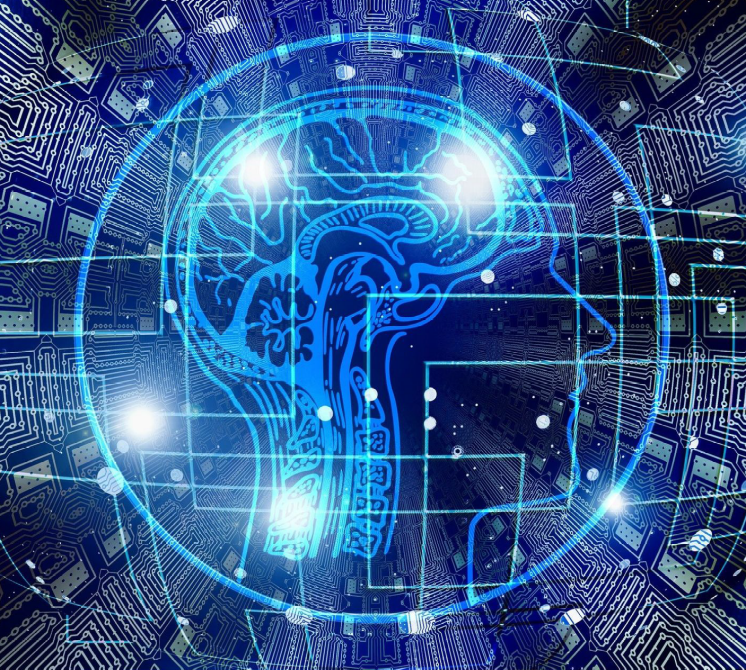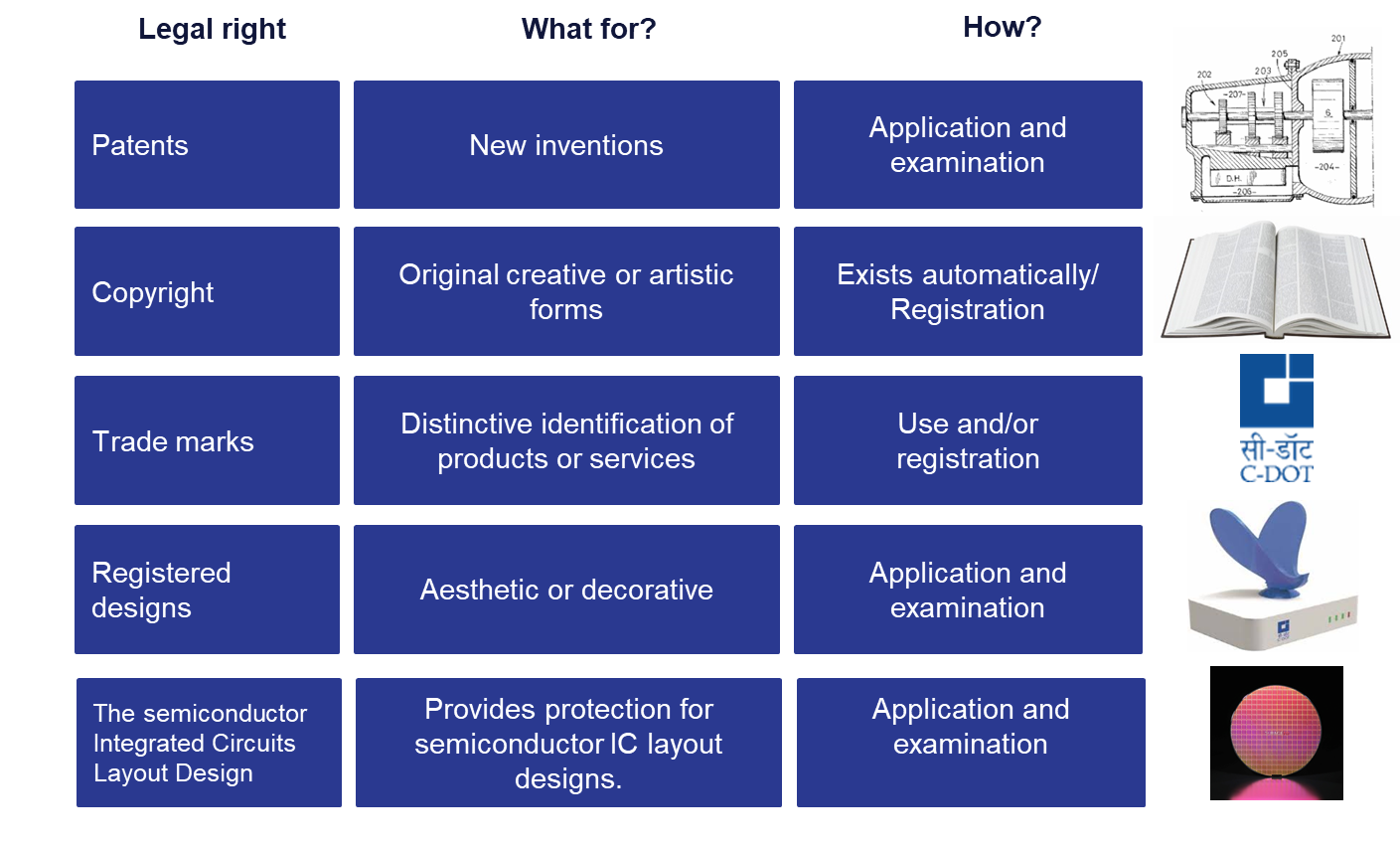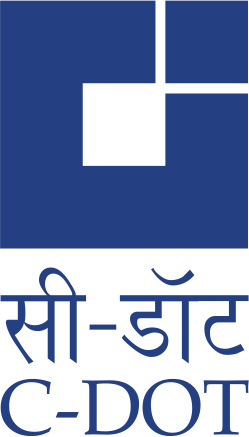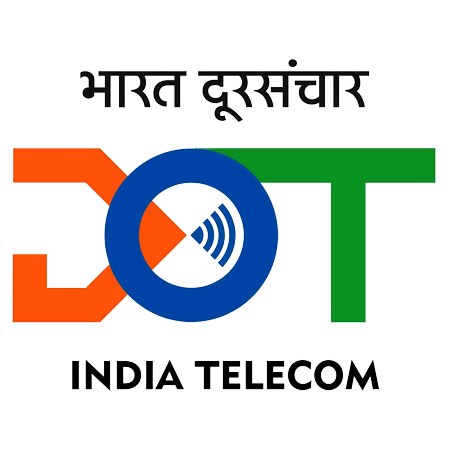IPR Facilitation
Intellectual Property Rights (IPRs)
Explore our comprehensive resources and streamlined processes to support your intellectual property rights (IPRs) and needs in emerging technologies.Focus on IPRs is important for researchers working on advanced and emerging technologies. In today’s dynamic and knowledge-based industrial environment, IPRs are key elements needed to maintain a competitive edge. The R&D community, scientists, and engineers need to be aware of the basic concepts and rules of IPR and its implications in their day-to-day activities. The National IPR Policy 2016, encompasses all IPRs into a single vision document setting in place an institutional mechanism for implementation, monitoring, and review of IP laws.
Intellectual property is a category of property that includes intangible creations of the human intellect. The creation and ownership of IPR is a source of national wealth and essential for economic leadership in the global market scenario.


It is a limited right granted by the State to an inventor in respect of an invention to exclude any other person from practicing the invention i.e. manufacturing, using, or selling the patented product or from using the patented process, without due permission. Inventions in all fields of technology can be patented whether they are products or processes, if they meet the criteria of
- Novelty - Invention not known to public prior to claim by inventor. Novelty (newness) in an invention depends upon the state of prior art, i.e., the existing knowledge and similar inventions already known in the particular field. There will be no novelty, if there has been prior publication and prior use of same or an identical invention. In other words, the invention must involve any innovation or technology which has not been anticipated by publication in any document or used in the country or elsewhere in the world before the date of filing of patent application. The subject matter must not have fallen into the public domain.
- Usefulness (Industrial application): The invention, besides being new and non-obvious, must also be useful. If the invention cannot be put to any beneficial use of mankind, it cannot be patented.
- Usefulness (Industrial application): The invention, besides being new and non-obvious, must also be useful. If the invention cannot be put to any beneficial use of mankind, it cannot be patented.
Copyright protects literary and artistic works e.g. Books, lectures, dramatic and musical works, choreography, cinematography, drawings, paintings, architecture, sculpture, photographs, illustrations, maps, plans sketches, computer programs etc.
Registered Designs protect the external appearance of a product. They do not give any protection for technical aspects or functionality. They include new patterns, ornaments, and shapes.
A trademark is a distinctive sign, which identifies certain goods or services as those produced or provided by a specific person or enterprise which distinguish them from products or services provided by competitors. The system helps consumers identify and purchase a product or service because of its nature and quality, indicated by its unique trademark, which meets their needs.
The semiconductor Integrated Circuits Layout protection, provides protection for semiconductor IC layout designs. SICLD Act is sui-generis (one of its kind) specifically meant for protecting IPR relating to Layout-Design (Topographies) of Semiconductor Integrated Circuit.

Ask our Experts
Have questions or need assistance? Our dedicated support team is here to help.
Patents for inventions, Designs for industrial designs and Trademarks for marketing products are collectively known as Industrial Property. These forms of industrial property along with the copyright in literary, artistic and similar works are referred to as Intellectual Property. Any property, movable or immovable has to be protected in order to prevent it from stealing. Similarly, the rights in the property created from the intellectual efforts of an individual also need to be protected from infringement. The results of such intellectual efforts have come to be known as Intellectual Property. IP is a category of property that includes intangible creations of the human intellect. Creation & ownership of IPR is a source of national wealth and mark of an economic leadership in the context of global market scenario.
A patent is a grant given by the State in the form of a certificate for disclosing an invention by which certain exclusive rights are conferred on the patentee (proprietor) for a limited period. A patent, therefore, is a property, which like any other property, movable or immovable, may be bought, sold, assigned or licensed. A Patent is an exclusive monopoly granted by the Government to an inventor over his invention for a limited period of time.
A Trade Mark is a visual symbol in the form of a word, a device or a label as applied to an article of manufacture or commerce with a view to indicate to the purchasing members of the public about the origin of the manufacture of the good affixed with such a mark. It facilitates to distinguish such goods from the goods manufactured by others in the trade.
A design is an idea or conception as to features of shape, configuration, pattern or ornament applied to an article. Such designs form a special branch of industrial property.
Copyright is basically, the right to copy and make use of literary, dramatic, musical, artistic works, cinematographic films records and broadcast. Copyright is a proprietary right and comes into existence as soon as the work is created. In recent times the term literary work includes computer software programs.
Patents give the patentee (proprietor) the right to take legal action to prevent other people from exploiting a patented invention without the proprietor’s permission. A person who develops an invention does not need a patent for commercializing it. He already has the right to commercialize the invention if a patent does not already protect it. However, if the invention is not patented, he does not have the legal right to stop others from working the invention.
The grant of a patent for an invention does not guarantee the merit or any other commercial value of the invention disclosed. The State (country) that grants the patent also does not guarantee the validity of the patent granted.
To enjoy the exclusive rights over the invention. If the inventor does not get patent rights over his invention and introduces his product/process based on his invention in the market, anyone can copy his invention and exploit it commercially. To prevent others from using, selling, or working out his invention, the inventor must obtain a patent.
To encourage innovation and investment in research and development activities so that there is economic, industrial, and technological development in the country.
A patentee is an applicant for a patent who is entered in the Register of Patents maintained in the Patent Office and is the grantee or proprietor of the invention disclosed in the patent. In the case of C-DOT, the patentee is C-DOT, not the constituent group of C-DOT or the employees of C-DOT.
No, to enforce the legal rights in a patent, the patentee should keep a strict watch to ascertain whether someone is infringing his rights in the patent without his permission and decide on the appropriate legal action to stop such infringement and claim damages.
No, the legal rights in a patent can only be enforced within the territorial limits of the country that grants it. For example, legal rights in patents granted in India can be enforced only in India, and those granted in the USA can only be enforced in the USA.
There is no such thing as a 'World Patent' or 'International Patent'. A patent granted by a country is valid and the legal rights can only be enforced within the jurisdiction of that country. Separate applications must be filed in each desired country according to that country's laws and procedures.
A US patent is granted by the United States Patent Office to an inventor who has filed an application with it, whereas an Indian Patent is granted by the Indian Patent Office to an inventor who has filed an application with the Indian Patent Office. A patent granted by a patent office is applicable only within the geographical boundaries of that country.
Not all inventions are patentable. The inventions that are patentable in a country are specified in the patent legislation of that country. In India, the Patents Act, 1970, which governs the grant of patents, lays down the conditions for an invention to be patentable. To secure a patent under the Act, the invention must be: new and useful, involve an inventive step or be non-obvious, and be capable of industrial application.
The novelty of an invention is judged by considering the knowledge available anywhere in the world in the relevant field at the time of filing the application for a patent. In other words, the invention should not be publicly known anywhere in the world prior to the filing of the patent application.
Disclosure of the invention to the public by the inventor himself before filing the application for a patent, through publication or exhibition, would prejudice the novelty of the invention and hinder subsequent patenting.
An invention is considered to have an inventive step if, when compared to what is already known, the invention would not be obvious to someone with reasonable knowledge and experience in the subject.
Industrial application means that the invention must take practical form, such as an apparatus, device, a product like new material, compound, substance, or an industrial process producing that product. Any improvement of the above is also included in this category.
No, certain categories of inventions that satisfy all the criteria of patentability may still not be patentable. Such categories are specified in the patent legislation of the country concerned.
In India, Sections 3 and 4 of the Patents Act, 1970, specify categories of inventions that are not patentable, including abstract theories, principles, discoveries, new uses of known substances, simple admixtures (non-synergistic), treatment of human beings, animals, plants, and inventions relating to atomic energy.
Examples of patentable inventions include processes for the production of new compounds, improvements of existing processes for known compounds, development of new machines or devices, or improved machines/devices, and synergistic compositions (except those that fall under food/drug).
A patent is obtained by the inventor or his assignee by filing an application with the patent office in the stipulated forms required by the Patent Act of that country.
An application for a patent may be made by any person, whether a citizen of India or not, claiming to be the true and first inventor of the invention, or his assignee, or his legal representative of a deceased person who was entitled to make the application before his death. The application may be filed alone or jointly with any other person. The term 'person' includes the government.
A patent application includes bibliographic information (title of the invention, date of filing, country of filing, inventor's name, etc.), background of the invention (state of the art, shortcomings, and the problem defined by the inventor), description of the invention (detailed description with examples and diagrams), and claims (establishing rights over the state of the art).
Though the inventor can draft the application, it is advisable to hire a patent attorney. Reviewing closely related patent applications already filed or granted can be very helpful.
An application should be filed as early as possible after developing the invention at the laboratory level, without delay until the invention is commercially viable.
No, the filing should not be deferred. Delaying can result in losing the novelty of the invention due to public disclosure. The application should be filed immediately after successful laboratory development.
No, a company or a firm cannot be named as the true and first inventor; the inventor must be a natural person. A firm or company can apply for a patent by virtue of an assignment from the true inventor.
Those who have contributed intellectually to the invention should be named as inventors, regardless of their position or qualifications. Proper records of the work done by project members are essential.
No, a patent is not granted for inventions that are publicly available, including published literature.
An inventor must disclose the invention so that any skilled person in the art can work out the invention based on the information provided.
Before starting research, to avoid re-inventing the wheel, during development to find technical solutions, or when filing a patent application to refine claims.
Before starting a research and development project or when facing a technical problem, as a significant portion of patent literature is not published elsewhere.
National patent offices, international information vendors like Dialog, Orbit, Questel STN, Inpass, PatentScope, and various patent websites.
Studying patent documents can prevent re-inventing solutions already found and available in the literature.
Publication before filing a patent application will result in loss of novelty. Therefore, the patent application should be filed first, and publication can occur afterward, provided essential features are disclosed.
If an invention covered by a patent application in India is also to be protected in foreign countries, technology transfer should be deferred until all applications in the desired countries are filed.
Yes, provided no one else has the legal rights to such an invention in the country concerned. This commercialization will prevent others from obtaining a patent for the said invention but won't prevent them from copying it.
No, a patentee does not receive money upon the grant of a patent. However, when a patentee sells their patented invention to a third party, they can receive money. The patentee has the right to sell their invention exclusively or non-exclusively, or to sell it for a royalty.
No, commercialization does not need to be deferred. The patent grant procedure is lengthy, so commercialization can occur before a patent is granted, provided a secrecy agreement is executed with the prospective client.
Yes, the technology can be transferred immediately after filing the application, but it's essential to execute a secrecy agreement with the party receiving the technology to protect the interests in the pending patent application.
The documents required are: a) The appropriate application form, b) The document (called specification) disclosing the invention, c) Drawings, if any, in support of the invention disclosed, d) The prescribed fees.
The patent specification contains the scientific and technical details of the invention proposed to be protected. It may be either provisional or complete.
The provisional specification discloses only the essence of the invention and does not contain essential features or a statement of claims. It does not confer legal rights.
The complete specification includes full details of the invention and a statement of claims, defining the scope of legal protection. Legal rights accrue from the date of filing the complete specification.
No, it's not necessary. An application can be filed with a complete specification directly, but a provisional specification helps register priority and safeguard novelty.
Yes, the complete specification must be filed within 12 months of filing the provisional specification, or the application will be treated as abandoned.
Yes, the information disclosed in abandoned applications will remain confidential, and a fresh application can be filed if the invention has not been made public.
No, both are independent documents. The provisional specification helps establish the priority date of the invention.
The statement of claims defines the scope of protection sought, with the first claim being the principal claim. Claims should clearly define the invention, not its advantages.
On average, it takes about five years to secure a patent in India, and the grant takes retrospective effect from the date of filing the complete specification.
The term of a patent refers to the period for which the exclusive rights in the invention can be exercised by the patentee. In India, patents for drugs, medicine, and food last 5 years from the date of sealing or 7 years from the date of patent, whichever is shorter, while all other inventions last 20 years.
It is the sole responsibility of the patentee to ensure that their patent is not being infringed upon. The patentee must file a suit against the infringer.
To keep a patent in force, the prescribed annual renewal fees must be paid on time. Failure to pay these fees will result in the patent lapsing, and the invention will become public property.
A patent can expire in several ways: (a) it has lived its full term, typically 20 years; (b) the patentee has failed to pay the renewal fee; (c) its validity has been successfully challenged.
No, once a patent lapses or its term expires, its novelty is lost, and it cannot be registered again.
Yes, if a patent lapses due to non-payment of renewal fees, it can be restored by applying to the Controller of Patents within one year of lapsing, provided the non-payment was unintentional and there was no undue delay.
No, using the information contained in patent documents for R&D and education does not constitute patent infringement and can be done without permission from the patentee.
Standards or Technical specifications are documents that establish rules or guidelines for a technology to ensure device interconnectivity and interoperability. They result from technical discussions held under the auspices of Standard Setting Organizations (SSOs), such as ETSI or IEEE.
An Essential Patent or Standard Essential Patent is a patent that claims an invention that must be used to comply with a standard. Such patents protect technologies essential for compliance with standards.
Patents and standards both encourage innovation and the diffusion of technology. Standards organizations require members to disclose and license patents that cover their standards. Failure to secure licenses for essential patents may lead to unlicensed patent owners demanding royalties from companies adopting the standard.
SEPs are powerful patents that encompass core technology mandatory for compliance by other businesses, allowing SEP holders to earn significant royalties. In contrast, regular patent holders can decide whether to license their inventions.
'Essentiality' is evaluated through two types of analysis: Technical analysis, which matches patents to standards requiring advanced technical knowledge, and Legal analysis, which involves subjective claim interpretation and typically arises in disputes.
Click Link to view further details.
NOTE: Above table contains patents filed & granted in India to foreign MNC in India and Indian companies and declared at ETSI database via IPR Statement & Licensing Declaration (ISLD) documents.
Click Link to view further details.
NOTE: Above table contains patents filed & granted in India to foreign MNC in India and Indian companies and declared to TSDSI.
Click Link to view further details.
NOTE: Above table contains patents filed & granted in India to foreign MNC in India and Indian companies and they are not SEPs since they are not declared to any Standards Setting Organization.


